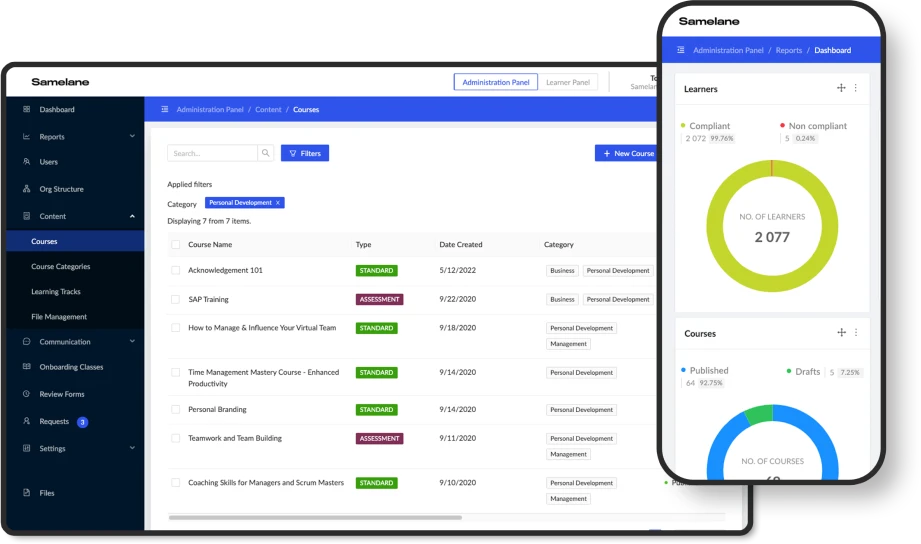Every organization strives for peak performance and productivity from its employees. However, there are times when employees may experience a decline in their performance or fail to meet certain expectations. Implementing an Employee Improvement Plan, also called PIP, can effectively address these issues, provide guidance, and help employees reach their full potential. This article will explore examples of PIPs and provide insights into writing an effective plan that fosters professional growth and boosts employee performance.
What is Performance Improvement Plan?
A Performance Improvement Plan is a structured document that outlines specific performance goals and expectations for an employee struggling to meet the required standards. It serves as a roadmap for improvement, identifying areas of concern and providing a clear path toward enhanced performance. It is a structured approach that allows employers to address performance issues constructively and supportively rather than resorting to disciplinary measures.
The purpose of a PIP is to provide a clear roadmap for the employee to enhance their skills, meet performance expectations, and contribute effectively to the organization. It is important to note that a PIP should be viewed as a developmental tool rather than a punishment. The ultimate goal is to help employees succeed and reach their full potential within the company. A well-executed PIP can help employees enhance their skills, overcome performance challenges, and contribute positively to the organization’s success by setting clear goals, providing guidance, and fostering a supportive environment.

counter the Big Quit with high retention strategies
Key elements of a Performance Improvement Plan
Implementing a Performance Improvement Plan is a powerful strategy to address performance gaps and enhance employee productivity. A well-crafted PIP provides a structured framework for guiding employees toward meeting performance expectations and achieving professional growth. Understanding the crucial components of a PIP is essential to support struggling employees and unlocking their full potential effectively. A well-designed PIP typically includes the following components:
- Assessment: The first step in developing a PIP is to evaluate the employee’s performance fairly and objectively. This assessment involves gathering data, reviewing performance metrics, and collecting feedback from supervisors, peers, and other relevant stakeholders. The assessment should identify specific areas where improvement is needed.
- Clear Goals: Once the areas of improvement are identified, the next step is establishing clear and measurable goals aligning with the organization’s objectives. These goals should be specific, realistic, and achievable within a defined timeframe. Setting SMART goals (Specific, Measurable, Attainable, Relevant, and Time-bound) helps ensure clarity and focus.
- Actionable Steps: The PIP should outline specific actions, strategies, and resources the employee can utilize to achieve the established goals. This may include recommending training programs, assigning a mentor or coach, or providing additional resources and support. The actionable steps should be tailored to the employee’s needs and designed to address the identified performance gaps.
- Timeline: A realistic timeline is essential for monitoring progress and providing regular feedback. The PIP should include specific milestones and checkpoints to assess the employee’s improvement over time. Regular check-ins, progress reviews, and feedback sessions should be scheduled to ensure the employee stays on track and receives the necessary guidance and support.
- Supportive Environment: Creating a supportive work environment that encourages open communication, collaboration, and growth is crucial. Managers and supervisors play a vital role in supporting employees throughout the PIP process. They should provide ongoing feedback, address any obstacles or challenges that may arise, and offer resources and assistance as needed.
- Consequences and Follow-Up: The PIP should communicate the potential consequences if the employee fails to meet the established goals within the specified timeframe. However, it is essential to emphasize that the purpose of the PIP is to help the employee succeed, and termination should not be the primary focus. If the employee demonstrates consistent improvement and meets the goals outlined in the PIP, a follow-up plan should be developed to ensure their continued growth and success.
Performance Improvement Plan examples
By providing a structured roadmap for improvement, PIPs offer specific goals, strategies, and support to guide employees toward success. Whether it’s enhancing time management, improving communication skills, or boosting sales performance, these examples will showcase the versatility and effectiveness of PIPs in driving positive change.
- Time Management Improvement: If an employee consistently misses deadlines, a PIP could focus on improving time management skills. This may involve setting clear priorities, implementing effective scheduling techniques, and accurately utilizing productivity tools to enhance efficiency.
- Communication Enhancement: In cases where an employee struggles with effective communication, a PIP can emphasize developing active listening skills, articulating ideas clearly, and seeking feedback to improve interpersonal interactions.
- Sales Performance Enhancement: A PIP for a sales representative might include setting targets for lead generation, enhancing product knowledge, honing negotiation skills, and improving customer relationship management.
How to write an effective Performance Improvement Plan?
Writing an effective Employee Improvement Plan requires careful consideration and attention to detail. Here are some key steps to follow when creating one:
- Gather Relevant Information: Collect objective data, performance metrics, and feedback from supervisors or colleagues to understand the employee’s areas of improvement. This information will provide a solid foundation for developing the PIP.
- Define Clear and Measurable Goals: Set specific, measurable, attainable, relevant, and time-bound (SMART) goals that align with the employee’s role and the organization’s objectives. Clear goals provide a roadmap for improvement and allow for objective evaluation of progress.
- Identify Actionable Steps: Outline specific actions and strategies that the employee can undertake to achieve the identified goals. These steps should be realistic and relevant to the areas of improvement. For example, consider incorporating training programs, workshops, coaching, or mentoring to provide necessary support and resources.
- Establish a Realistic Timeline: Define a timeline with a reasonable period for the employee to progress. Break the goals and action steps into manageable milestones and establish checkpoints for progress reviews and feedback sessions. Regular check-ins are crucial for tracking progress and making any necessary adjustments.
- Communicate Clearly and Constructively: Ensure that the PIP is written in a clear, concise, and constructive manner. Use objective language and provide specific examples to illustrate areas of improvement. Clearly articulate expectations, the purpose of the PIP, and the support that will be provided to facilitate growth and development.
- Involve the Employee: Encourage the employee’s participation in creating the PIP. Inviting their input and allowing them to share their perspective fosters ownership and commitment to the improvement process. Collaboratively discuss goals, action steps, and strategies, and ensure they clearly understand the plan.
- Establish Ongoing Support and Monitoring: Communicate the support available to the employee during the PIP period, such as regular check-ins, coaching, or training resources. In addition, provide ongoing feedback, guidance, and support to ensure the employee feels supported and motivated throughout the process.
- Review and Evaluate Progress: Regularly review the employee’s progress against the established goals and milestones. Provide constructive feedback and recognition for achievements. Adjust the plan if necessary to address any unforeseen challenges or changes in circumstances.
- Follow-Up and Continued Development: Once the employee has successfully met the goals outlined in the PIP, establish a follow-up plan to ensure continued growth and development. This may include ongoing training, mentorship, or periodic performance reviews to sustain positive changes.
Harnessing the power of Performance Improvement Plans for enhanced productivity
The Performance Improvement Plan is a valuable tool for organizations to address performance issues, empower employees, and drive overall success. Employers can effectively support their employees in achieving their full potential by exploring real-life examples of PIPs and understanding the critical components of a well-written plan. By setting clear goals, providing actionable steps, and fostering a supportive environment, a thoughtfully crafted PIP can unlock the untapped potential within individuals and teams. In addition, with the assistance of a Learning Management System, organizations can streamline the process of creating, implementing, and monitoring PIPs, enabling enhanced productivity, professional growth, and long-term success. Embrace the power of PIPs to transform performance and unlock the potential of your workforce.












